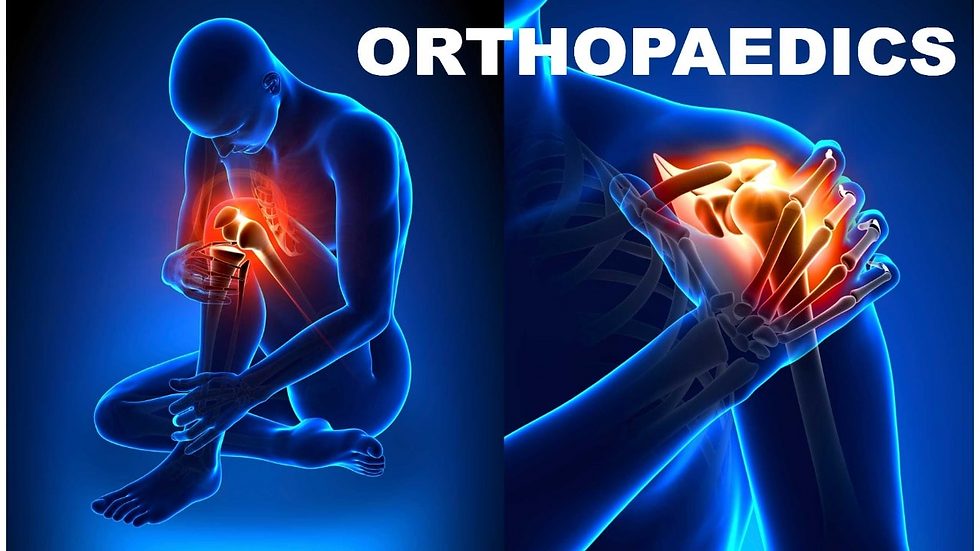What Keeps Us Moving Freely Every Day?
- George Abraham
- May 15
- 4 min read
Have you ever stopped to think about how naturally you walk, run, stretch, or even pick up objects? These effortless movements are facilitated due to an amazing system within your body—the musculoskeletal system. And when it does require support, care, or recovery, that's where orthopaedics is introduced. Orthopaedics is the branch of medicine that deals with bones, joints, muscles, ligaments, and tendons—the same components that allow movement and stability in daily life.
Understanding Orthopaedics
Orthopaedics is a field of healthcare specializing in musculoskeletal conditions. Whether it is joint pain associated with aging, an injury occurring while participating in a sports event, or a posture problem accumulated over time, orthopaedics provides a means of enhanced mobility and function. The main intention of orthopaedics is to enable people to live more easily by preserving or regaining the ability to move and perform everyday activities.
Over time, the profession has matured greatly with integration of newer diagnostic and surgical approaches and more rigorous rehabilitation. As a result, individuals across a wide range of ages—young children and geriatric patients included—are able to get proper attention specific to each one of their requirements.
Why Movement Matters
Movement is critical to human existence, not only for function, but for wellness. Whether playing with kids, taking a walk in the park, engaging in sports, or just doing simple daily activities, having the capacity to move without pain significantly increases quality of life. Orthopaedic care enables this freedom of movement. It's not only about fixing an issue when it happens but also maintaining joint and muscle health through preventive measures.
Regular exercise, sound posture, sound diet, and listening to the body are all important. But when issues do happen, early consultation with an orthopaedic expert can make a huge difference.
Common Areas Orthopaedics Treats
Orthopaedics encompasses a wide range of conditions, from acute injuries to long-term health issues. Injuries like sprains, fractures, and dislocations often receive immediate treatment, whereas joint-related issues, such as those involving the knees, hips, or shoulders, can take longer to resolve with treatments. Tendon and ligament strains, spinal misalignment, and overuse injury are also included in this practice.

Besides, orthopaedics entails care of developmental disorders in children, sports medicine, and age changes in bone density and joint structure. The breadth of areas within orthopaedics makes it possible for specialists to provide personalized solutions for various needs and life stages.
Role of Non-Surgical and Surgical Approaches
One of the key elements of orthopaedic care is the use of a balanced treatment regimen. Although surgery is a possibility in certain situations, numerous issues are treatable by non-surgical means like physiotherapy, injections, braces, or controlled exercise regimens. These involve the alleviation of pain, strengthening of afflicted regions, and overall musculoskeletal support.
When surgery is required, it tends to be as minimally invasive as possible. Advances in technology have allowed for faster recovery and more accurate interventions, so people can resume their normal routines with greater comfort and mobility.
The Importance of Early Intervention
Most orthopaedic issues build up over time and can begin with subtle symptoms. A mild stiffness in the knee, intermittent backache, or pain with repetitive tasks is often an early warning sign. Being aware of these signs and presenting early for evaluation makes for better care.
Early intervention facilitates conditions' management before complications set in. Orthopaedic professionals can examine the condition, provide suitable imaging where necessary, and offer tailored care plans. Early treatment benefits not only the recovery process but also the prognosis in the long run.
Orthopaedics Across the Lifespan
From children experiencing growing pains or congenital conditions, to athletes managing sports-related injuries, and older adults navigating age-related changes—orthopaedics serves all age groups. Children may benefit from treatments that support proper development, while active adults often seek guidance for performance maintenance and injury prevention. As people age, joints and bones may require more attention, and orthopaedics can provide strategies to maintain strength, flexibility, and comfort.
Rehabilitation is vital in all ages. Returning the movement, gaining strength, and enhancing balance are just a few of the objectives that assist a person in returning to their lifestyle.
Living an Active and Comfortable Life
Orthopaedics care is synonymous with overall health. A healthy and well-supported musculoskeletal system allows people to remain active, engage in hobbies, and enjoy the rhythm of life without restriction. Whether it's through sports, dancing, gardening, or being able to sit and stand comfortably, the rewards of a healthy structure are truly felt.
Healthful musculoskeletal function also results in emotional wellness. Physical movement is intimately tied to mental status, and activity not only supplies physical power, but confidence and independence.
Conclusion
Everyone has the right to move freely, comfortably, and with confidence. Orthopaedics assists in making this a reality by helping individuals take the path towards improved posture, alignment, strength, and ease of movement. With education, prevention, and treatment, orthopaedic care enables people to live a lifestyle of health and vitality.
At Adam Vital Hospital, our staff can offer full orthopaedic care specifically designed to support your movement, comfort, and long-term musculoskeletal well-being.

Comments